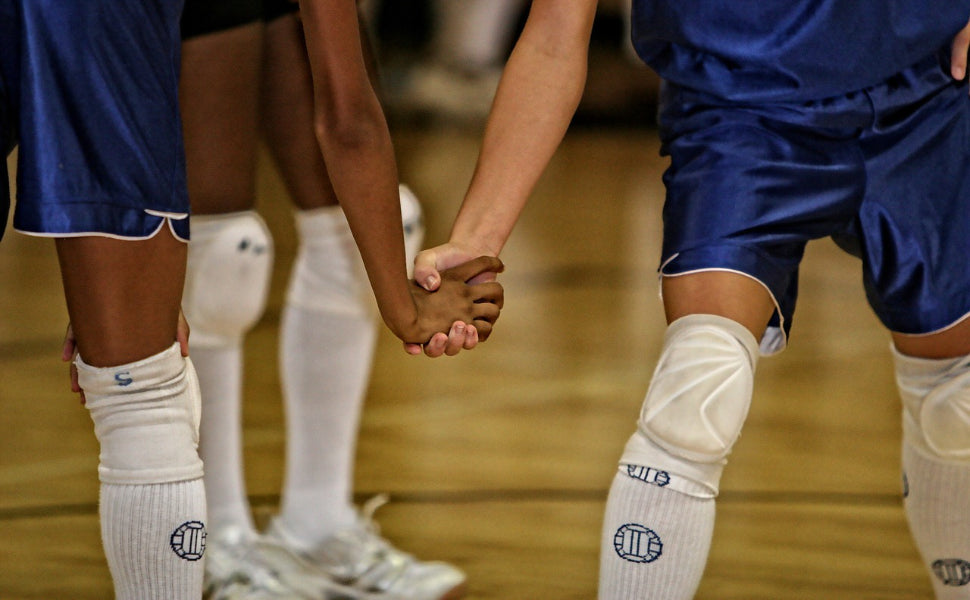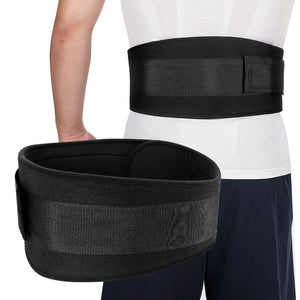How to Prevent Injuries in Volleyball (2024 updated)

When it comes to playing volleyball, injuries are unfortunately common. The fast-paced nature of the game, along with frequent jumps, dives, and sudden movements makes players particularly susceptible to a variety of injuries. Whether you're an experienced or novice volleyball player, understanding how to prevent injuries in volleyball is crucial.
This article aims to share valuable insights on how to prevent injuries in volleyball and ensure that everyone can enjoy volleyball safely. By taking the right precautions and using appropriate protective gear, you can largely reduce the risk of getting hurt on the court.

Potential Injury Sites in Volleyball
Understanding the common injury sites in volleyball and why they are prone to injury can help you take specific measures to protect these areas. Here are the four main areas that are most susceptible to injuries during volleyball:
1. Ankle
The ankle is one of the most frequently injured sites in volleyball. Due to the constant jumping, landing, and quick lateral movements, players often experience sprains and strains. Ankle injuries can occur from landing awkwardly after a jump, stepping on another player's foot, or sudden directional changes. These injuries can be particularly debilitating, affecting your ability to move swiftly and balance effectively on the court.
2. Knee
Knee injuries are also common among volleyball players. The repetitive jumping and landing put a significant amount of stress on the knee joints. Conditions such as patellar tendinitis (jumper’s knee) and ACL (anterior cruciate ligament) tears can occur from the high-impact activities involved in the sport. Poor landing mechanics and insufficient strength in the muscles surrounding the knee can increase the risk of these injuries.
3. Wrist
The wrist is another vulnerable area, especially given the frequent need for players to block, set, and spike the ball. These actions can lead to sprains, fractures, and tendinitis due to the high velocity and force exerted on the wrist. Diving and falling can also contribute to wrist injuries, especially if players use their hands to break their fall. Proper wrist protection and strength training can help mitigate these risks.
4. Finger
Finger injuries are particularly prevalent in volleyball, often resulting from blocking and setting the ball. The fingers can get jammed, fractured, or dislocated when coming into contact with the ball at high speeds or from awkward angles. These injuries, while sometimes perceived as minor, can significantly impact a player’s ability to perform.
How to Prevent Injuries in Volleyball
Preventing injuries in volleyball requires a combination of proper preparation, technique, physical conditioning, and the right protective gear. Here are some essential strategies to keep you safe on the court:
1. Have Adequate Warm-up
A proper warm-up is essential before any volleyball game or practice session. It boosts blood circulation to your muscles, improves flexibility, and prepares your body for the intense physical activity to come. Start with light cardio workouts such as jogging or skipping, followed by dynamic stretches that replicate volleyball movements. Pay particular attention to stretching your ankles, knees, wrists, and fingers to minimize the risk of injuries in these areas.
2. Exercise Volleyball Techniques
Mastering proper volleyball techniques is vital for injury prevention. Incorrect techniques can put unnecessary stress on your joints and muscles, leading to injuries. Consult a coach or experienced player for the correct form for jumping, landing, spiking, setting, and blocking. Pay attention to your body mechanics and practice drills that reinforce good habits. Consistently using proper techniques not only improves your performance but also protects your body from injury.
3. Have Regular Physical Training
Regular physical training helps build strength, endurance, and flexibility, all of which are essential for preventing injuries in volleyball. Focus on training that strengthens the muscles around the most injury-prone areas, such as the ankles and knees. Incorporate strength training, plyometrics, and balance exercises into your routine. Conditioning your body to handle the demands of volleyball will make you more resilient and less prone to injuries.
4. Use Protective Gear
Using the right protective gear is another effective way to prevent injuries in volleyball. Knee brace for volleyball, wrist braces, ankle braces, and thumb supports can provide additional stability and protection to vulnerable areas. When choosing protective gear, consider factors like material, size, design, price, and brand. Fivali offers a range of high-quality protective gear designed specifically for volleyball players. Wearing the appropriate gear can make a significant difference in preventing injuries and ensuring you stay safe on the court.
How to Select the Right Protective Gear for Volleyball
Selecting the right protective gear is essential for averting injuries and ensuring your safety on the volleyball court. When selecting gear, consider factors such as material, size, design, price, and brand. At Fivali, we offer a range of high-quality protective gear tailored to meet the specific needs of volleyball players. Here are some of our top recommendations:
Fivali Volleyball Knee Brace Extra Long FKR11
|
Feature |
Description |
|
Dual EVA Protective Pads |
Provides superior cushioning and protection for your knees. |
|
Increased Length |
Offers extended protection, covering both the knee and shin areas. |
|
Elastic Fabric |
Ensures a comfortable and secure fit, allowing for a full range of motion. |
The Fivali Volleyball Knee Brace Extra Long FKR11 is meant to offer maximum protection and comfort. The dual EVA protective pads provide excellent cushioning, while the increased length ensures both your knee and shin are well-protected. The elastic fabric offers a snug fit without restricting your movement, making it an ideal choice for preventing knee injuries.
Fivali Adjustable Ankle Compression Wrap 2 Pack FAR02
|
Feature |
Description |
|
Wrap-around Design |
Allows for adjustable tightness to suit your comfort and support needs. |
|
Extended Design |
Provides better protection and support for your ankles. |
|
Open-heel Design |
Ensures breathability and comfort, reducing the risk of overheating. |
The Fivali Adjustable Ankle Compression Wrap 2 Pack FAR02 features a wrap-around design that allows you to adjust the tightness for optimal support. The extended design offers comprehensive protection, while the open-heel design ensures your feet stay cool and comfortable. This ankle brace for volleyball is perfect for preventing sprains and providing stability during intense volleyball matches.
Fivali Wrist Brace for Sports with Aluminum Plate – 1 Pack
|
Feature |
Description |
|
Aluminum Plate Support |
Provides rigid support to stabilize your wrist and prevent injuries. |
|
Replaceable Resin Support Strip |
Offers additional support that can be customized to your needs. |
|
Detachable Compression Strap |
Allows for adjustable compression to reduce pain and inflammation. |
|
Breathable Mesh Fabric |
Ensures comfort and prevents sweating, keeping your wrist cool and dry. |
The Fivali Wrist Brace for Sports with Aluminum Plate is designed to offer maximum support and stability for your wrist. This wrist brace for volleyball features an aluminum plate that provides rigid support, while the replaceable resin support strip allows for customization. The detachable compression strap offers adjustable compression, and the breathable mesh fabric ensures comfort during prolonged use.
Fivali Thumb Spica Splint Brace 1 Pack FWR01
|
Feature |
Description |
|
Thumb Protection |
Provides targeted support to prevent thumb injuries. |
|
Metal Support |
Offers additional stability and protection for your thumb. |
|
Aid in Injury Recovery |
Helps in the recovery process by providing necessary support and immobilization. |
|
Seamless Integration into Daily Life |
Designed for comfort and can be worn throughout the day without discomfort. |
The Fivali Thumb Spica Splint Brace FWR01 is perfect for protecting your thumb and aiding in injury recovery. This thumb support for volleyball offers targeted protection with its metal support feature, ensuring stability and safety. This volleyball thumb brace is designed to seamlessly integrate into your daily life, providing comfort and support throughout the day.

Knowing how to prevent injuries in volleyball is crucial for maintaining your performance and enjoying the sport safely. By understanding the common injury sites and implementing strategies such as adequate warm-up, practicing proper volleyball techniques, regular physical training, and using the right protective gear, you can largely lower the risk of injuries.
Choosing the right gear is essential for providing the necessary support and protection to vulnerable areas. At Fivali, we offer a range of high-quality protective gear designed specifically for volleyball players. They assist in protecting your knees, ankles, wrists and fingers. Our products are made to offer maximum protection and comfort, helping you stay safe on the court. Browse our website to learn more about our braces/supports and find the perfect gear to suit your needs.













